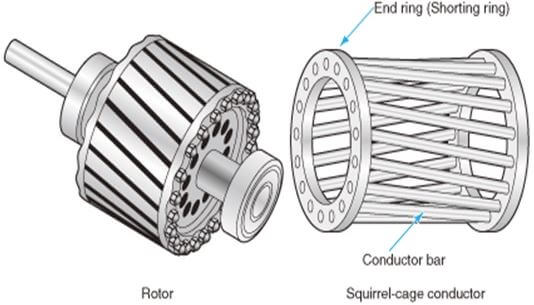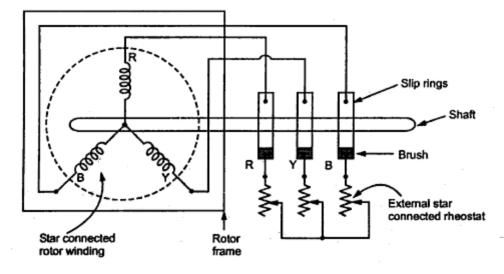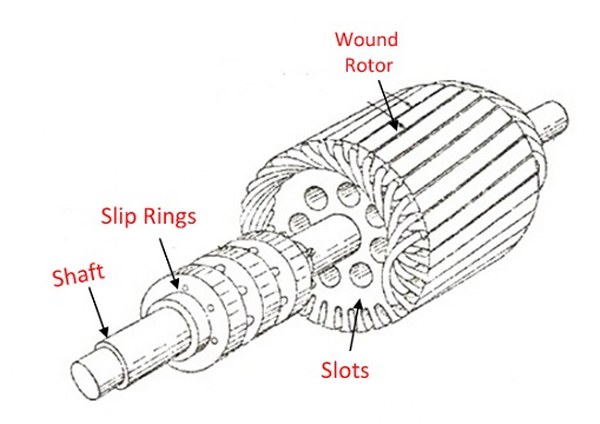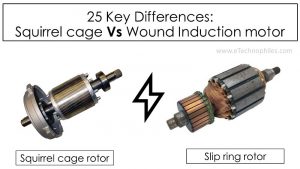Last updated on March 23rd, 2024 at 01:35 pm
If we classify an induction motor based on the type of rotor used, there are two types of induction motor. The first is a Squirrel cage Induction motor, and the other is a Wound, aka slip ring Induction motor. Both these induction motors have a difference in their construction, starting, cost, and application. This article covers all the differences between squirrel cages and wound induction motors.
The table below gives a quick view of the differences between squirrel cages and wound induction motors.
Differences between squirrel cage and wound induction motor
| Squirrel cage Induction motor | Carbon brushes are present in a slip-ring induction motor. |
| The rotor of a squirrel cage induction motor uses cylindrical copper bars. | The rotor of a slip ring induction motor uses a distributed 3-phase winding. |
| The copper bars are shorted at the ends by circular end rings. Hence, the rotor looks like a squirrel cage. | The end terminal of each winding connects to a slip ring mounted on the rotor shaft. |
| Carbon brushes are absent in a squirrel cage induction motor. | Carbon brushes are present in a slip ring induction motor. |
| The absence of slip rings and brushes makes the construction simple. | The overall construction becomes complex due to the presence of slip rings and brushes. |
| It requires less maintenance due to the absence of slip rings and brushes. | The brushes wear out after some time, so it requires frequent maintenance. |
| We can’t add external rotor resistance to this motor. | We can easily add external rotor resistance to this motor. |
| The copper losses are low in this motor. | The copper losses are high in this motor. |
| The starting current for this motor is high. | The starting current for this motor is low. |
| This motor gives a low starting torque. | Due to the presence of external rotor resistance, this motor gives a high starting torque. |
| It is not possible to start this motor with a rotor resistance starter. | A rotor resistance starter can start a wound induction motor. |
| The rotor copper losses are low. | The rotor copper losses are high. |
| The cost of this motor is low. | The cost of this motor is high. |
| The efficiency of the cage motor is high. | The efficiency of the wound rotor is low. |
| It has a better pull-out torque. | Its pull-out torque is less than the cage rotor. |
| It has low rotor overhang leakage flux. | It has more rotor overhang leakage flux. |
| The starting power factor for this motor is poor and can’t be improved. | It is possible to improve the starting power factor for this motor. |
| The operating power factor for this motor is higher. | It operates at a comparatively lesser power factor. |
| Speed control of this motor is not possible. | Speed control of this motor is possible. |
| The absence of slip rings eliminates the risk of sparking. | Sparking problem occurs due to the presence of slip rings. |
| Its overloading capacity is low. | Its overloading capacity is higher than a squirrel cage induction motor. |
| Due to more space in a squirrel cage motor, the cooling is better. | The cooling is not that good as compared to a squirrel cage induction motor. |
| Its maximum power output capacity is higher. | Its maximum power output capacity is lower than a squirrel cage induction motor. |
| The energy lost during starting is more. | The energy lost during starting is less. |
| Due to its simple construction and low cost, the squirrel cage induction motor is widely used in industries. | Fans, drill machines, lathe machines, and printing machines use a squirrel cage induction motor. |
| Fans, drill machines, lathe machines, printing machines use a squirrel cage induction motor. | The slip-ring induction motor is rarely used in industries. |
Table of Contents
After a quick view, it’s time to look at the differences between squirrel cage and wound induction motor in detail.
Construction

The squirrel cage induction motor uses copper or aluminum bars to make the rotor conductors. On the other hand, the slip ring induction motor uses a 3-phase winding on the rotor, similar to the stator winding. They also require slip rings and brushes. Hence, the overall construction of the squirrel cage induction motor is simple and rugged.
Copper losses
A slip ring induction motor uses a 3-phase winding as the rotor conductors. On the other hand, the squirrel cage induction motor uses conductive bars. So, the overall copper requirement in a slip ring induction motor is more. Hence, as the electric current flow through them, more losses and heat is produced.
External rotor resistance

The rotor bars in a squirrel cage induction motor contain end rings. It creates a permanent short-circuit path, and hence, there is no possible way to add external resistance to the rotor. But, in a slip ring induction motor, the brushes and slip rings are present. This arrangement makes it possible to insert external resistance to the rotor conductors.
Starting methods
There are four ways to start a squirrel cage induction motor: DOL, Primary resistance, Auto-transformer, and Star-Delta. These methods can also work for a slip ring induction motor, but a better way to use a rotor resistance starter.
Starting current and torque

The presence of external resistance in the slip ring induction motor gives two advantages:
- It decreases the starting current for the induction motor.
- It increases the starting torque for the induction motor.
But, as there is no way to connect an external resistance in a squirrel cage induction motor, the starting current is higher, while the starting torque is low.
Speed control
By varying the external rotor resistance, it is possible to achieve different speeds in a slip ring induction motor. But, the rotor resistance is absent in a squirrel cage induction motor. So, its speed control is not possible.
Maintenance
Due to numerous advantages, carbon is the preferred material to make brushes. But, as the brushes slide over the slip rings continuously, the brushes wear out after some time. Hence, a slip ring induction requires more care and maintenance when compared to a squirrel cage induction motor.
*Image courtesy

